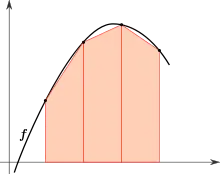Integration as Reverse Differentiation
Power Rule
The power rule for differentiation states that:
The reverse of this is , which can be written as
This is the power rule for integration.
Exponentials & Logarithms
Regarding the derivatives of exponentials and logarithms, we know that:
Reversing these, we get:
The natural logarithm takes a modulus input so that it can handle negative numbers.
Note that similar rules apply to any linear expressions that may be composed with these functions:
Trigonometric Functions
The derivatives of the trigonometric functions are:
Thus, the corresponding integrals are:
As with exponentials and logarithms, this applies to linear expressions that are composed with trigonometric functions:
Using Trigonometry when Integrating
Sometimes, it is useful to use trigonometric identities when finding the integral of an expression.
e.g. Find the integral .
Trapezium Rule

The trapezium rule states that the area under a curve can be approximated by finding the sum of the areas of trapeziums. The area of a trapezium is given by Where is the length of the longer side, is the length of the shorter side, and is the length of the perpendicular distance between the sides.
In the context of the trapezium rule, each trapezium's perpendicular distance is a constant : the width of each trapezium. The lengths of the sides are given by points on a curve. Thus, for a curve approximated using trapeziums, each trapezium has an area .
The area under the curve between the bounds and is the sum of the trapeziums' areas: .
Because is constant, the expression for the area can be written , which can be simplified to
Thus, the trapezium rule states: